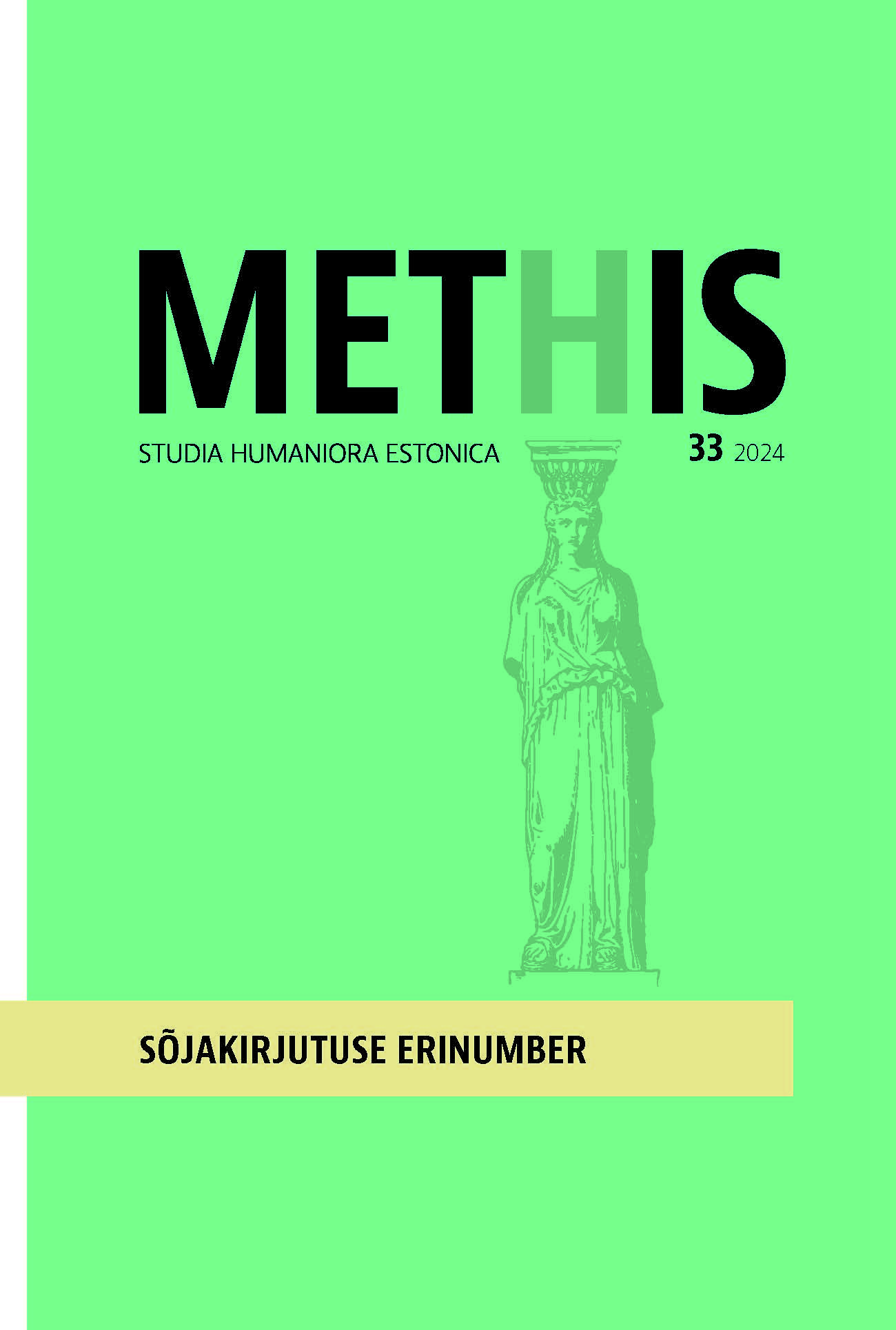Sõjakäsitlus tavateadvuses: Esimene maailmasõda tänapäeva noorte silme läbi / Lay Representations of War: The First World War through the Eyes of Today’s Youth
DOI:
https://doi.org/10.7592/methis.v26i33.24126Keywords:
First World War, representations of history, lay representations of war, Esimene maailmasõda, ajaloo representatsioonid, sõjakäsitlus tavateadvusesAbstract
Teesid: Sõjakäsitlus tavateadvuses on paljukihiline: selles on nii isikliku/perekondliku kogemuse elemente kui ka kollektiivsete ajalookujutluste ühtlustavaid mõjusid. Esimene maailmasõda on meist ajas sellisel kaugusel, kus see on muundunud sündmuse esialgsest kommunikatiivse mälu vormis meenutamisest institutsionaliseeritud kultuurimälu osaks. 2014. aastal viidi kahekümnes Euroopa riigis läbi üliõpilaste küsitlus, selgitamaks tänapäeva noorte kollektiivseid kujutlusi Esimesest maailmasõjast. Artiklis kirjeldame Eesti noorte Esimese maailmasõjaga seotud arusaamu ja võrdleme neid teistes Euroopa riikides elavate noorte arusaamadega. Eraldi analüüsime vastuseid küsimusele „Mida saame õppida Esimese maailmasõja kogemusest?“.
Lay understanding of war is multi-layered containing elements of personal or family experience as well as the unifying effects of collective memory (representations). The First World War is at such a distance from us that a change in the form of collective historical representation has taken place, from the initial commemoration of the event in the form of communicative memory to part of institutionalised cultural memory (Assmann 2008). According to today’s view, the First World War is second most important global historical event (Liu et al. 2005).
In 2014, one hundred years after the beginning of the First World War, a survey of students was conducted in twenty European countries (within the framework of COST Action IS1205 Social Psychological Dynamics of Historical Representations in the Enlarged European Union) to investigate the commonalities and differences in social representations of the War among young Europeans. Young people were asked about their factual knowledge of the War, their family war experiences, feelings related to the War, and more general interpretations of the war such as what they considered the main causes of the War to be, who was attributed the responsibility for the outbreak of the War, how they evaluate the violence of the different parties, how they perceive the distribution of the roles of aggressor and victim, etc. Background characteristics included cultural and national identity, anti-war attitudes, etc. In Estonia, the survey was conducted in both Estonian and Russian. In the article, we describe the main results of these studies.
Previous analysis found that Europeans share a common representation of the causes of the First World War, although young people in Western and Eastern European countries have different interpretative frameworks when thinking about this war (Bouchat et al. 2019a; Pawliczek 2014). While in Western Europe it is the tragic Great War, with a definite beginning and end, in Eastern Europe there is not such a clear collective perception. The First World War led to various other wars in these countries, as a result of which empires fell apart and many small countries, including Estonia, gained independence, paradoxically a positive consequence of the War for these nations. Awareness of family or national war victimhood is linked to anti-war attitudes today; for more pacifist young people the First World War is associated with real and emotional human suffering, while less pacifist young people think more abstractly about the geopolitical results of the War (Bouchat et al. 2019b).
Young people growing up in peacetime Europe after the Second World War have generally been free from militaristic propaganda. There has been a purposeful attempt to shape young people’s approach to history in schools, the trend of which in most European countries has been to reconcile former enemies (Rosoux et al. 2019). The survey discussed in the article showed considerable commonality and consensus in the representation of the First World War. The descendants of the former hostile parties evaluate this war in the same way, can reproduce the same facts, events, and characters, and interpret the causes and consequences of the war similarly. Looking back, young people primarily see the futility of War and the unnecessary human suffering. Thus, pacifism as one of the cultural consequences of the War is a viable common sense way of thinking today. Analysing Estonian war literature, Jaan Undusk (2016) has come to the conclusion that ‘passive pacifism’ and indifference to war are characteristic of Estonians.
Unlike the communicative memory of the Second World War, where former intergroup enmity is still alive at times, in the collective cultural memory of the First World War, emotionality has faded and transformed; for example former war excitement or rage has become sadness and grief. Instead of enmity between countries and peoples, one sees rather a social conflict between greedy and reckless elites and ordinary people sacrificed for their interests (Bouchat et al. 2019a). One hundred years later, the First World War appears to the youth of Europe as a warning, a negative symbol that is contrasted with united Europe as a peace project (Bouchat et al. 2023). In this way, history has been transformed into a shared symbolic resource, war in collective memory acting as a supporter of international peace. Young people have developed a homogeneous anti-war-oriented collective image of the First World War.
Estonian youth’s factual knowledge of the First World War was surprisingly good, considering the marginality of this war from the point of view of Estonian identity or current inter-group relations: Estonians do not feel like victims or war criminals, they do not feel the desire for revenge, there is no need to forgive anyone or demand an apology from anyone. We separately analysed Estonian young people’s answers to the question "What can we learn from the experience of the First World War?" Generalising the answers, we can conclude that most young people took a progressive, linear view of history, according to which war is an anomaly, a disease of society that can and should be prevented. The lessons of the First World War were primarily perceived as ways of preventing future conflict and avoiding the mistakes made in the past, both at the level of individuals, social groups (the elite), and society as a whole. A stable and peaceful world was perceived as the norm.


